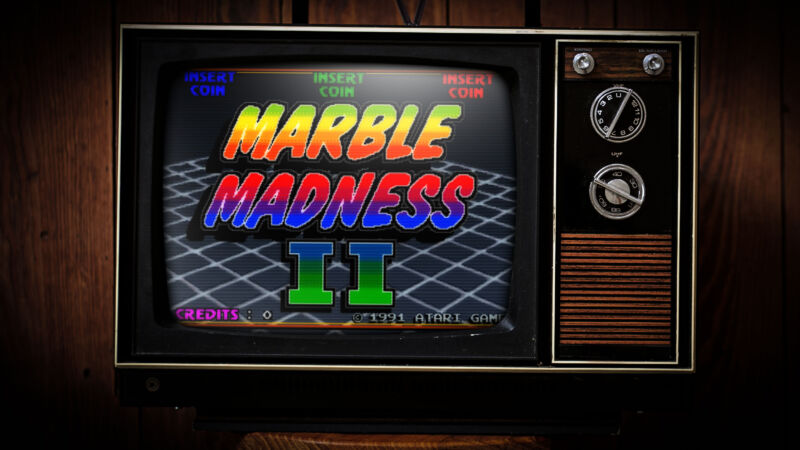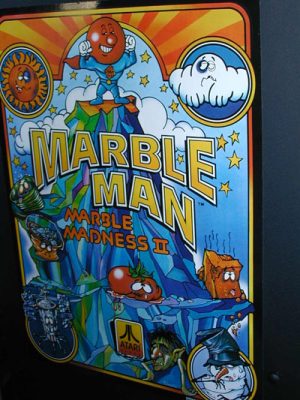
After confirming the ROM's authenticity by comparing its gameplay to extant footage, we looked into the how and why of getting this game running via emulation—and talked to community experts about Marble Madness II's unique mix of exciting arcade history and disappointing gameplay.
A tale of two sequels
First, a bit of background. In 1991, seven years after the hit release of Marble Madness, Atari Games set out to create a sequel that included "more of everything," as designer Bob Flanagan put it in a 2020 interview with Antstream. That prototype sequel, subtitled Marble Man, packed in 17 large and complicated mazes, loads of new enemies, three-player support, a pinball-style bonus game, and even power-ups that let players fly across the level or crush threats in their path.
Initial tests of Marble Man cabinets with internal focus groups and at an external test location didn't go well, though. While that might have been the result of stiff competition from flashier new cabinets like Street Fighter II, Atari blamed the performance on the game's trackball controls.
"From the Focus we learned that the trakball [sic] is the more intuitive control to roll a marble, and that it is the desired control for the high-end player," Atari wrote in an internal "Changes to Marble Madness II" document archived by the historians at AtariGames.com. "But, the joystick was perceived as an easier control for a beginner to learn the game. Thus, we would like to change the trakball to a joystick and see if we gain a wider audience."
We all love a good 'what if' story, [and] unreleased games like this are the closest we get to peeking into alternate realities.Video Game History Foundation Founder Frank Cifaldi
Flanagan would later call the shift to a joystick-and-accelerator-button control scheme a "mistake" driven by a lack of faith in players. "By the time the game was to come out, more people had played the game that way in the home market and didn’t even know what a trackball was," he told Antsream.
Early Marble Man testers also reportedly reacted badly to brief animations where the marble transformed into a humanoid superhero with a face, spouting goofy sound clips like "The Adventures of Marble Man" (as seen in this footage from a collector). These transformations were described as "hokey, stupid, and meaningless," according to Atari documents, leading the team to "remove Marble Man from the entire game" for a second prototype.
"I made the design choice to target too young an audience with the Marble Man character," Flanagan told Antstream. "I should have kept it abstract like the original."
The second, trackball-free, Marble-Man-free Marble Madness II prototype reportedly didn't do much better than the first in limited location tests. Rather than rework the game yet again, Atari Games quickly scrapped wider production plans for Marble Madness II to refocus on Guardians of the Hood, a simple brawler featuring digitized human actors. Marble Madness designer Mark Cerny, who was not involved with the development of either sequel prototype, told Next Generation magazine in 1997 that "at most 10 to 12 boards exist" of the ill-fated Marble Madness II.
The leak
Marble Madness II hasn't been completely lost since those ill-fated tests, though. Diligent collectors have been able to obtain a few complete cabinets over the years, sometimes by assembling parts from multiple sources. Some of those cabinets have regularly been available for play at retro gaming shows like California Extreme, too, allowing a wider group of arcade fans a chance to play the historical oddity.
Before this week, though, the dumped, emulation-ready ROM files from those prototypes had never been made publicly available online. That situation changed on May 21, when a ROM image of Marble Madness II started spreading via sites like the Internet Archive and 4chan.
If you’re an upcoming game developer or designer, it’s important to study not only games that succeeded but also games that failed.MAME developer David Haywood
There's little evidence to suggest who might be the original source of the leaked ROM, save for the unhelpful handle "dank2079." Some digital sleuths have suggested that 20-year-old timestamps on the ROM files suggest this was an old dump that has just recently been leaked. But, as longtime MAME contributor David Haywood suggested to Ars, "that theory is flawed as sometimes those reading ROMs are using 30-year-old PCs where the onboard clocks no longer work simply because the latest drivers for their EEPROM programmer were for Windows 95."
"I think the most likely explanation is the simplest: a PCB turned up, the owner dumped the ROM data from it and put it on The Internet Archive, not wanting the attention it would bring with a more public announcement," Haywood continued. "PCBs of unreleased and thought-to-be-lost [arcade] games show up all the time—the count is almost double digits this year already—even if none are quite as high-profile as Marble Madness II."
Owners of rare video game hardware and prototypes can be extremely protective of the code underlying their artifacts, as we've previously seen with the alleged theft of the ROM code for Atari prototype Akka Arrh. That protective behavior could stem come from a belief that wider ROM availability would make their rare cabinets less valuable in the collector's market.But some doubt whether playable ROM leaks like these are actually damaging to the value of a rare collectible. Arcade Heroes blogger and arcade owner Adam Pratt told Ars in 2019 that he felt the leak of Akka Arrh's code "won't diminish the value of the existing machines. If anything, it will probably enhance it, since more people will know about it now."
"My outsider understanding is that unlike home video game prototypes, the value for an arcade cabinet skews much more toward the physical cabinet itself," Video Game History Foundation founder Frank Cifaldi told Ars Technica. "I cannot imagine that extremely limited test cabinets from a 'cult following' company like Atari can do anything but increase in value over time."
Say my MAME
Even with access to the leaked ROM, interested parties couldn't immediately play Marble Madness II on the latest stable release of MAME. "The thing with arcade games is that, unlike a console ROM or disk image where you can usually just drop the file into an existing emulator to play, the arcade ROMs were designed to run on a purpose-built hardware setup, so require additional work to check," Haywood told Ars. After hearing about the ROM leak from a friend, Haywood said he got to work coding a MAME driver that could verify the ROM file's contents.
Luckily, Haywood didn't have to start from scratch. "Atari reused common design patterns across many of the hardware platforms used by their games, and thanks to the work of Aaron Giles, who worked on the emulation of a huge number of the Atari games of the '80s and '90s, many of these common patterns have been implemented in a modular, easy to reuse way within the MAME codebase," Haywood told Ars.
On a hardware level, the Marble Madness II ROM doesn't closely resemble its 1984 predecessor. Instead, Haywood said the board most closely matches Atari's 1991 Batman arcade game, right down to the identical soundboards on both machines. Haywood said he also looked at other contemporary Atari releases, like 1990's Rampart, for reused bits of code like palette handling routines. "It’s all a bit like Lego, working out which pieces to use and how they fit together," he said.
All told, Haywood said it took about four hours to patch together existing Atari emulation code and to update MAME's source code to support Marble Madness II. "The most difficult part of emulating Atari games is usually the copy protection, but luckily, and likely due to still being a prototype, Marble Madness II didn’t employ any of Atari’s usually devious devices," he said.
With the source code update, players (and Ars) have been able to match the gameplay in the leaked ROM to existing footage of Marble Madness II from trade shows (the fully compiled "stable build" of MAME will likely reflect the updates in the coming weeks). But longtime Marble Madness fans may be sad to learn that this leak represents the second, trackball-free prototype of the game, which definitely suffers somewhat for its reliance on joystick controls.
Haywood says there "don't seem to be any active remains of the trackball code in the [leaked] ROM" on a cursory glance. That said, he allowed that future ROM hackers may be able to add trackball support back to the prototype by modifying the code for marble direction and velocity. But Haywood also warns that "chances are the game didn't see much rebalancing when the control scheme was changed to joysticks + turbo in the first place. If the physics etc. have been heavily tuned for the joystick inputs, it may still not feel right even with a trackball."

With one more "lost game" now found, Haywood still holds out hope that the earlier Marble Man prototype will also be leaked. "It would be fascinating to be able to study that older version, too, and see if maybe the problems ran deeper and the failure to perform well in location tests [was] misdiagnosed," he said.
A historical footnote?
Despite its status as a sought-after "lost game" and a historical oddity in the emulation community, the Marble Madness II prototype doesn't get much respect from retro game fans as a game.
"Marble Madness II is a classic example of [when] a beautiful game is created and the sequel completely forgets why the original was great," the Internet Archive's Jason Scott told Ars. "I am excited that this long-anticipated game is out in the wild, because people can realize how uninteresting the game is and move on."
Cifaldi agreed, saying, "I've been playing this game at public expos for about 20 years now and, frankly, it isn't my cup of tea; it doesn't hold up to the original at all."
But that doesn't mean the release is unimportant from a historical preservation perspective. "It's tempting to call this a historical footnote in Atari's output, but an event's historical significance can often be driven by the general public's interest, and what I've seen over all these years is that this is consistently a holy grail lost game of its era," Cifaldi said.
I am excited that this long-anticipated game is out in the wild, because people can realize how uninteresting the game is and move on.Internet Archive Librarian Jason Scott
"I think Marble Madness captured a lot of imaginations, and whether the sequel was worthy of it or not, it's hard not to be compelled by the idea of it. We all love a good 'what if' story, [and] unreleased games like this are the closest we get to peeking into alternate realities."
Haywood agreed that "in the bigger picture, it is just another failed Atari arcade prototype." At the same time, though, he suggested the emulated leak still had value in "get[ting] people talking about MAME in a positive light and [raising] awareness of these lost games."
"It’s a bigger piece of news for those wanting to learn about games than it is to the MAME community," Haywood continued. "If you’re an upcoming game developer or designer, it’s important to study not only games that succeeded but also games that failed, and to be able to do in-depth analysis on them. Marble Madness was a universal hit; the sequel, which should have been a guaranteed success, never made it out the door. Being able to post mortem these failures is a valuable way of building knowledge and avoiding similar mistakes."
Technology - Latest - Google News
May 26, 2022 at 05:45PM
https://ift.tt/GfBQzXp
After 30 years, the world can now play the lost Marble Madness II - Ars Technica
Technology - Latest - Google News
https://ift.tt/v9sY7Tl
https://ift.tt/SkTle4Z

0 Commentaires